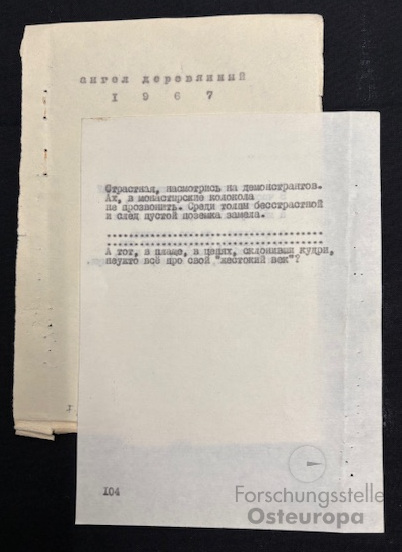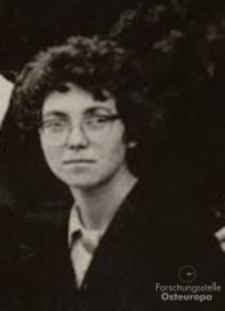Kolloquiumsvortrag
18:15 Uhr, / Zoom
Benjamin Goossen (Boston)
Mennonites and Lebensraum. Situating a Christian Denomination in Hitlers Empire.
Wissenswertes
Forschungsstelle Osteuropa
Die Forschungsstelle Osteuropa (FSO) ist als An-Institut eine außeruniversitäre Forschungseinrichtung an der Universität Bremen. Sie wird gemeinsam von der Kultusministerkonferenz und dem Land Bremen finanziert. Im Jahre 1982 mitten im Kalten Krieg gegründet, versteht sich die FSO heute als ein Ort, an dem der Ostblock und seine Gesellschaften mit ihrer spezifischen Kultur aufgearbeitet sowie aktuelle Entwicklungen in der post-sowjetischen Region analysiert werden.
Aktuelle PressebeiträgeGefangen zwischen Front und Grenze?» weiterlesen Wenn nebenan Krieg ist » weiterlesen |
Aktuelles aus Forschung & ArchivAlltagshilfe für tschechoslowakische Migrant:innen» weiterlesen Facetten nationaler Identität: Die Ukraine » weiterlesen |
Archivale des Monats
„Der Dekabristen Erben“
Zum Jahrestag des Dekabristenaufstands 1825 und der ersten Verfassungsdemo 1965

Gedicht von Natalia Gorbanewskaja über die erste Verfassungsdemo, 1967. Archiv der Forschungsstelle Osteuropa, Foto: Muriel Nägler.
Leidende, schau auf die Demonstranten.
Ach, die Klosterglocken
läuten nicht. Inmitten gleichgültiger Passanten
die leere Spur verdeckt von weißen Flocken.
[Das diensthabende Monster raucht im Hocken,
tut als Mensch, ist das verkehrt?…]
Und jener, im Mantel, in Ketten, mit gesenkten Locken,
meint nur sein „grausames Jahrhundert” er?
Das schrieb die Dichterin und Menschenrechtsaktivistin Natalja Gorbanewskaja (1936-2013) über die Demonstranten, die erstmals am 5. Dezember 1965 am Puschkin-Denkmal für die Einhaltung der Verfassung protestierten. Eine Demonstration in der UdSSR, die nicht Staat und Partei angeordnet hatten, war unerhört und verboten. Daher war es eine kleine Sensation, als sich vor 60 Jahren Menschen am Puschkin-Platz in Moskau zusammenfanden, um für die in der Verfassung garantierten Freiheiten und Rechte zu demonstrieren. Sie sahen sich selbst in der Tradition der Dekabristen, der Offiziere, die 140 Jahre zuvor im Dezember (daher ihr Name) 1825 versucht hatten, den plötzlichen Tod des Zaren Alexander I. zu nutzen, um die Autokratie zu stürzen. Sie waren überwältigt, ihre Anführer gehenkt und das Gros nach Sibirien verbannt worden.

Natalia Gorbanewskaja 1965. Archiv der Forschungsstelle Osteuropa, Foto: unbekannt.
Sie entwickelten sich schnell sowohl zum Mythos und als auch zum wunden Punkt der russischen Geschichte: zum einen imponierte, dass junge Männer und Frauen, die ihren Männern nach Sibirien gefolgt waren, bereit waren, Leben und Freiheit zu riskieren, um Russland in eine bessere Zukunft zu führen; sie waren ein Beweis dafür, dass es sehr wohl in Russland demokratisch eingestellte Kräfte gab; zum anderen entsetzte die Härte, mit der der Staat seine Elite bestrafte. Der Nationaldichter Alexander Puschkin (1799-1837) spielte dabei insofern eine Schlüsselrolle, da er damals selbst noch in Verbannung war, dem Zaren aber erklärte, wäre er in Petersburg gewesen, hätte er sich seinen revoltierenden Freunden angeschlossen. 140 Jahre später, im Jahr 1965, stand Puschkin als Statue auf dem gleichnamigen Platz in Moskau und an seinem Sockel prangte ein Zitat aus einem seiner berühmten Gedichte:
Und lange wird vom Volk mir Liebe noch erwiesen,
Weil mein Gesang erweckt Gefühle echt und tief,
Weil ich in grauser Zeit die Freiheit kühn gepriesen
Und Gnade für Gestürzte rief.
Andrej Sacharow (1921-1989), Atomphysiker, künftiger Nobelpreisträger und am 5. Dezember 1966 Demonstrant bei der zweiten Verfassungs-Demo, las diese Zeilen laut vor und übertrug damit Puschkins Ruf nach Freiheit in die sowjetische Zeit.
Gorbanewskaja band all das in ihrem Gedicht zusammen: die aktuellen Demonstrant*innen, das Leidenskloster, das einst auf diesem Platz gestanden hatte und 1937 abgerissen worden war, so dass seine Glocken nicht mehr Alarm schlagen konnten, die Passant*innen, die hastig weitereilten, den Schnee, der die Spuren der Demonstranten bereits bedeckte, die Staatsgewalt, die sie als „Monster“ beschrieb (was sie allerdings später strich, weil es ihr zu „platt“ erschien) und eben Puschkin selbst, „jener, im Mantel, in Ketten, mit gesenkten Locken.“ So, wie er einst von seinem „grausamen Jahrhundert“ gekündet hatte, übernahm sie diese Rolle, die Verbrechen des 20. Jahrhunderts erst nur in ihren Gedichten, ab 1968 auch in ihrer Untergrundzeitung „Chronik der laufenden Ereignisse“ zu dokumentieren. Ihr gesamtes Archiv übergab sie um 2010 an die FSO.
Die Dekabristen blieben Vorbild und Inspiration für die Menschenrechtsaktivist*innen. So reimte der nonkonforme Dichter Vladimir Batschew (*1947) über die erste Dezember-Demonstration 1965:
An jenem frostig-kalten Tag
erschien die Freiheit greifbar nah.
Nun wisst ihr, dass ihr statt Studenten
der Dekabristen Erben seid.
So fallen 2025 zwei Jahrestage zusammen: der des Dekabristenaufstands 1825 und der der ersten Verfassungsdemo 1965. In Putins Russland gelten die Freiheitskämpfer*innen der späten Sowjetzeit schon lange nicht mehr als Held*innen. Und auch die Dekabristen werden heute als selbstsüchtige Putschisten, eine Gefahr für den Staat und aktuellen Autokraten gesehen.
Susanne Schattenberg
Lesetipps
Gorbanevskaja, Natal'ja: Ni spi na zakate. Počti polnoe izbrannoe s primečanijami avtora, Sankt Petersburg 1996. Online verfügbar unter: https://royallib.com/read/gorbanevskaya_natalya/polnoe_sobranie_stihotvoreniy_19561994.html#0 [01.12.2025].
Schattenberg, Susanne: Natalja Gorbanewskaja, Graphic Novel: https://dissident.dekoder.org/natalja-gorbanewskaja/ [01.12.2025].
Ulickaja, Ljudmila (Hg.): Poėtka. Kniga o pamjati: Natal'ja Gorbanevskaja, Moskva 2014.
Weissbort, Daniel (Hg.): Natalya Gorbanevskaya. Selected poems, Manchester 2011.
Susanne Schattenberg ist Direktorin der Forschungsstelle Osteuropa und schreibt derzeit eine Biographie über Natalja Gorbanewskaja, die im Herbst 2026 beim Verlag C.H. Beck erscheinen wird.
Länder-Analysen
» Länder-Analysen
» Eastern Europe - Analytical Digests
Discuss Data
Archiving, sharing and discussing research data on Eastern Europe, South Caucasus and Central AsiaOnline-Dossiers zu
» Erdgashandel
» Hier spricht das Archiv
» Russian street art against war
» Dissens in der UdSSR
» Duma-Debatten
» 20 Jahre Putin
» Protest in Russland
» Annexion der Krim
» sowjetischem Truppenabzug aus der DDR
» Mauerfall 1989

